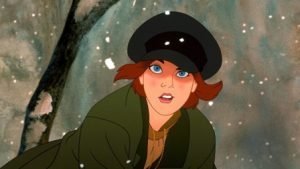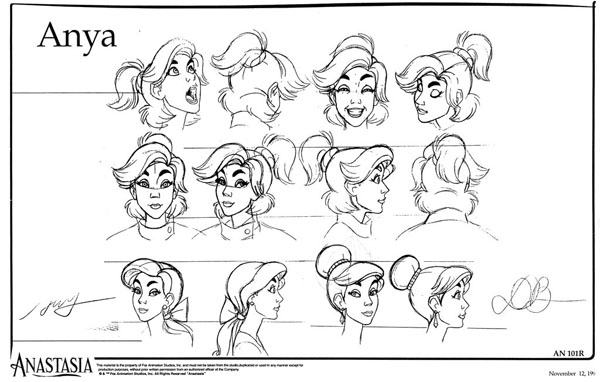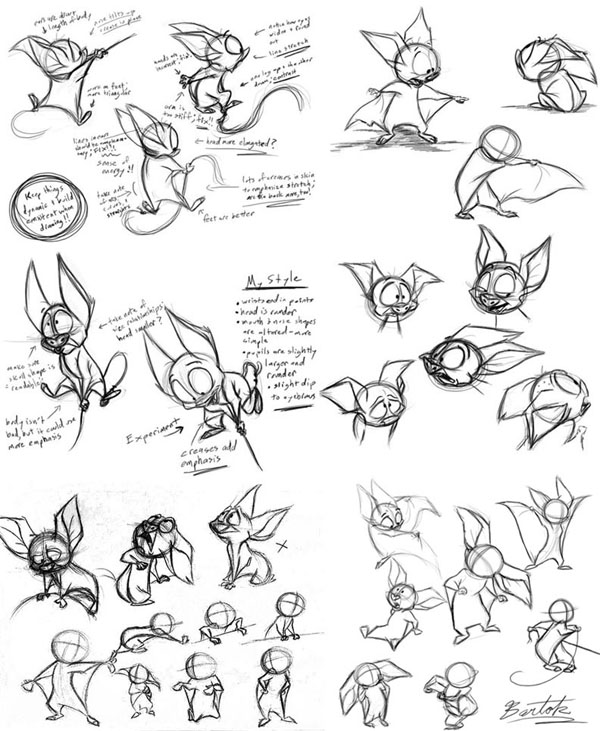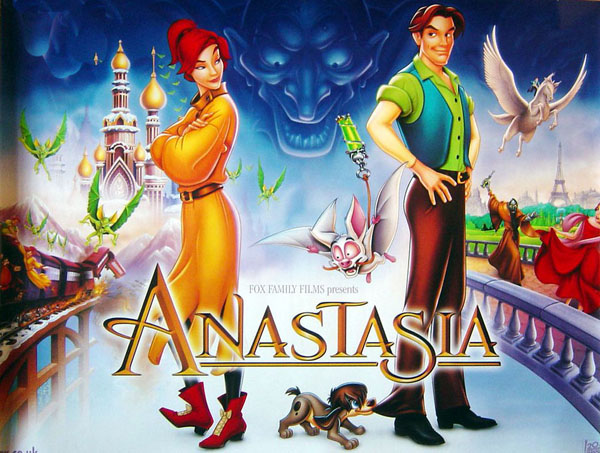 Don Bluth remembered when a “wake-up call” came for animation. “It happened around An American Tail, and that woke up the sleeping giant,” said Bluth in a 1997 interview. “[Disney] made Mermaid and Beauty and the Beast, and suddenly they got very interested in their competition, which made them try even harder. In that effort, they did something that put a sparkle on the water.”
Don Bluth remembered when a “wake-up call” came for animation. “It happened around An American Tail, and that woke up the sleeping giant,” said Bluth in a 1997 interview. “[Disney] made Mermaid and Beauty and the Beast, and suddenly they got very interested in their competition, which made them try even harder. In that effort, they did something that put a sparkle on the water.”
Part of that “sparkle” did come from Disney’s hits, propelling animation into a renaissance throughout the 1990s. But part of that also came from Bluth’s hit films, such as the aforementioned An American Tail in 1986 and 1988’s The Land Before Time.
 By 1997, the animation renaissance was raging, and other studios began throwing their hats into the ring. One of them was Twentieth Century Fox, which opened an animation studio in Phoenix, Arizona.
By 1997, the animation renaissance was raging, and other studios began throwing their hats into the ring. One of them was Twentieth Century Fox, which opened an animation studio in Phoenix, Arizona.
Fox brought Bluth into their new studio, along with his long-term creative partner, Gary Goldman. For the new studio’s first feature, they chose Anastasia, a story based on real-life incidents and rumors (which had been made as a live-action film in 1956 by Fox), set against the backdrop of the Russian Revolution: a government overthrown, a family torn apart, and a country in turmoil.
“If you put aside most of the preconceptions and start taking it apart, we saw that there was a lot of stuff that covers the same ground as fairy tales, most especially in terms of abandonment and fear of abandonment and how we deal with that,” said Anastasia’s producer Maureen Donley in 1997. “It’s something that’s innate to the human condition that no soul on this planet escapes.”

The film centers on young Princess Anastasia, who was living a charmed and royal life with her family in the Czar’s palace in Russia until the evil Rasputin places a curse on the family, which triggers the Russian Revolution. As her family escapes an angry mob storming the palace, Anastasia is separated from them.
Ten years later, Anastasia (Anya), now an orphan with no memory of her heritage, is sent out into the harsh world, where rumors abound in St. Petersburg that the lost Princess might still be alive. This is good news to all except Rasputin, who, assisted by his sidekick, Bartok, the albino bat, sets out to find the princess.
Meanwhile, Anya meets Dimitri, the one-time servant boy to the royal family, now grown up as a cocky con artist (they don’t recognize one another). Dimitri sees a way to capitalize on the rumor that Princess Anastasia might still be alive. Along with his sidekick, Vladimir, Dimitri convinces Anya that she could be the missing Princess, and they all go to Paris to claim her lost heritage.

Anastasia boasted an impressive cast of recognizable voices, including Meg Ryan as Anastasia, John Cusack as Dimitri, Kelsey Grammer as Vladimir, Angela Lansbury as grandmother Marie, Christopher Lloyd as the villainous Rasputin, Bernadette Peters as the sunny, optimist Sophie, and Hank Azaria as the comical sidekick, Bartok.
“When his first readings came back, personally, I wasn’t sure if it was going to work,” remembered co-director Goldman in 1997 of Azaria’s performance. “It was so dry it sounded like he was reading the line instead of acting the line. Then, when we laid it down next to Christopher Lloyd’s [dialogue], we knew that it was funny. You have one manic character set off against this other who is low-key and laid back. It turned out to be perfect.”
Goldman also added, “Bartok is Don’s personal addition to the film. He kept thinking, ‘If we’re going to have animated characters, let’s come up with something different and unique.’”

Anastasia also included an impressive musical score by Lynn Ahrens and Stephen Flaherty, Broadway veterans who also brought E.L. Doctorow’s Ragtime to the stage. Anastasia would also later inspire a Broadway musical adaptation that would debut in 2017.
The film Anastasia came together with a look and style that was reminiscent of Hollywood’s classic big-screen, big-budget musicals. “Since this is an epic story,” said Bluth. “We chose to do it in Cinemascope, and we chose to hide the graphics slightly, so it became more of a realistic look. It was more like getting involved in a live-action motion picture or a play, where you forget the craft and just get involved with the story. Our paramount goal was to get the audience to feel certain things deeply.”
This big-screen storytelling allowed for some impressive set pieces in Anastasia, such as one involving a runaway train and another centering on a storm at sea, which both involve remarkable animation and kinetic energy.
Opening on November 21, 1997, Anastasia found success at the box office and with critics. Some, however, were quick to note that the movie leaned heavily into the Disney animated musical paradigm. One of these was Owen Gleiberman in Entertainment Weekly, who wrote: “Anastasia has the Disney house style down cold: the musical numbers that sound like mid-‘60s Broadway, the gorgeous stately/psychedelic backgrounds, the funky beasties nattering on the sidelines.”

Anastasia also found inspiration in Disney’s marketing at the time, and Fox treated the film like an event when it was released that holiday season. It even had a budget that exceeded the previous year’s Independence Day. Commercials and promotions were inescapable, as were fast food “tie-ins,” toys, a float in the Macy’s Thanksgiving Day Parade, and a soundtrack that cracked the Billboard 50 with the single “At the Beginning.”
With all of this mirroring of Disney, it’s ironic that Anastasia would eventually become part of Disney when the company purchased 20th Century Fox in 2019.
Fox Animation Studios’ follow-up to Anastasia, 2000’s science-fiction film Titan, A.E. (also directed by Bluth and Goldman), was a box-office disappointment, and Fox Animation Studios sadly closed ten days after that film’s release.
Anastasia would prove to be not only Fox’s first in-house animated production, but also their most successful animated feature at the time. Looking Back at Anastasia it’s an impressive example of the artistry, energy, and creativity found at so many studios during the animation renaissance of the 1990s.
Bluth touched upon this when discussing Anastasia just before the film’s release. “After making seven animated pictures, the thing I know is that you can never know what’s going to happen,” he said. “With Anastasia, that one thing was the predictable. It was filled with serendipity, and the discoveries along the path of making this film were things I would have never imagined.” Bluth found one of these surprises in the film’s setting. “Anastasia, not knowing she’s the Princess yet, makes a journey into Paris, which was a city just being born and awakening to new things, ” said Bluth, adding, “So much was going on, which contrasted to the fact that Russia was a world dying and Paris was a world coming to life. All of these little nuances and currents began to surface, which gave something to us beyond just telling the plot points of the story; it’s describing the world in an era gone by and finding what is there in that era that we can learn from.”


 Michael Lyons is a freelance writer, specializing in film, television, and pop culture. He is the author of the book, Drawn to Greatness: Disney’s Animation Renaissance, which chronicles the amazing growth at the Disney animation studio in the 1990s. In addition to Animation Scoop and Cartoon Research, he has contributed to Remind Magazine, Cinefantastique, Animation World Network and Disney Magazine. He also writes a blog, Screen Saver: A Retro Review of TV Shows and Movies of Yesteryear and his interviews with a number of animation legends have been featured in several volumes of the books, Walt’s People. You can visit Michael’s web site Words From Lyons at:
Michael Lyons is a freelance writer, specializing in film, television, and pop culture. He is the author of the book, Drawn to Greatness: Disney’s Animation Renaissance, which chronicles the amazing growth at the Disney animation studio in the 1990s. In addition to Animation Scoop and Cartoon Research, he has contributed to Remind Magazine, Cinefantastique, Animation World Network and Disney Magazine. He also writes a blog, Screen Saver: A Retro Review of TV Shows and Movies of Yesteryear and his interviews with a number of animation legends have been featured in several volumes of the books, Walt’s People. You can visit Michael’s web site Words From Lyons at: 






















Considering that it is based on one of the most grim and grisly events in human history, the success of Bluth’s Anastasia is noteworthy and remarkable. Its two most notable predecessors were the 1956 Ingrid Bergman film and a 1980s TV miniseries starring Amy Irving. At the time of the animated film’s release, the mystery of Anna Anderson had still not been solved, adding to the film’s mystique. Discoveries have since been made of the remains of the two “missing” members of the royal family–Anastasia and her brother Prince Alexis. For many years various people came forth claiming to be one or the other of these two unaccounted-for persons, the most famous of course being Anna Anderson.
Its heavy duty real-life subject matter makes Anastasia something of an anomaly among animated films. Perhaps “Pocahontas” comes closest to depicting a real-life person in a reimagined animated form. There are truly impressive moments in the film. My favorite is the empty ballroom scene with the haunting melody of “Once Upon a December.” The threat of Rasputin seems a little bit tacked-on as though somehow there had to be an obligatory villain, in which case a dead villain was better than none at all. But for those like me who don’t feel his presence is all that necessary for telling the story, his involvement in most of the scenes is marginal. There is only one brief bit where Anastasia is directly aware of his menace, and this is quickly taken care of. The screenplay’s emphasis is firmly set on Anya and her quest for identity, which is as it should be. I would consider this overall as one of the more “adult” animated films. The animation throughout is astounding.
One more thing the film does successfully is to bring a happy ending and a sense of closure to a very dark chapter, despite the inescapable fact that Anya’s real-life counterpart did not live happily ever after.
Oh yes, the ballroom scene with Once Upon a December was one of the major highlights of Anastasia, and very iconic. The supernatural elements were good for what they were intended for, but if they were removed from the film, it wouldn’t have taken anything away from it.
There’s a lot to celebrate about “Anastasia”. It’s a striking film visually, musically, and dramatically, and there’s some strong emotion in its elements of romance and self-discovery. The celebrity cameos in the musical number set in Paris are very clever. I don’t have any problem with its reliance on live-action reference, as the technique suits the story and the historical setting. My main quibble with the film is its handling of the supernatural. The scenes with Rasputin are less horrific than disgusting, and it seems ridiculous to me that the source of his evil power could be destroyed simply by being stepped on — and by a young woman in delicate dress shoes, at that. But then, if I had been around in 1939, I probably would have snorted in derision at the idea that the Wicked Witch of the West could be defeated by dumping a bucket of water over her. What a world….
Thanks for filling in for Jim Korkis’s Animation Anecdotes on Fridays during his convalescence, Michael!
“‘Anastasia’ would prove to be not only Fox’s first, but also their most successful animated feature at the time.”
I believe Ralph Bakshi’s WIZARDS (1977) was actually Twentieth Century Fox’s first animated feature.
If we really wanted to be pedantic, HUGO THE HIPPO (1975) would’ve been Fox’s first.
True, and a good point.
But HUGO THE HIPPO was produced by Hungary’s Pannónia Filmstúdió and mostly backed by Faberge’s Brut Productions. Fox theatrically distributed the movie in the United States.
WIZARDS was financed and released by Twentieth Century Fox, which holds the copyright to the film.
It would be amusing if Wizards ended up on Disney+, but I’m not holding my breath.
As with The Hunchback of Notre Dame, this would have have been a much better film without the unnecessary “comic relief”.
All things considered, it works surprisingly well in its watered-down-for-the-kids way if you can handle Meg Ryan’s Valley Girl voice and the anachronisms. The Broadway version is boring.
I looked up my Netflix review of Anastasia from twenty years ago. Twenty years younger me couldn’t handle the songs at -all-. Twenty years ago I didn’t know my secret trick to enjoying something anyway for its good qualities, in this case the animation. Simple. If a song starts playing in a genre I can’t stand, just hit mute! I also used this trick whenever Gabby was screaming in my second watch of Fleischer’s Gulliver. People, the trick works.
Thanks for bringing up HUGO THE HIPPO in the comments section. Not only do I own the movie, but the small paperback picture book too. Sometimes old memories are the best.
2D animation will never die off, in fact in recent years it has only gotten more popular than CGI animation. There is a way to save Disney, but it requires patience and determination to take back the magic of the company. I hope I can succeed in the end.
I was born on September 23rd, 1997
One of the earliest ideas of having the movie be closer to the Anastasia musical, would have produced a result more respected today. And even something else, if Don wasn’t shackled by producers, would have been less of a Disney Formula ripoff.
Oh well, at least this led to Bartok the Magnificent, which has pretty much nothing wrong with it.